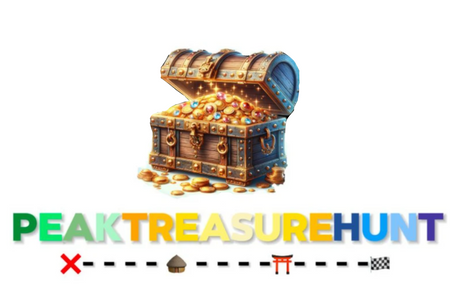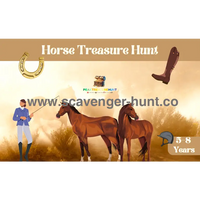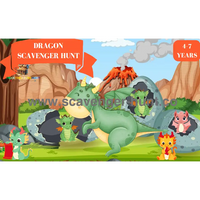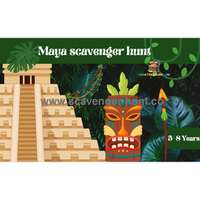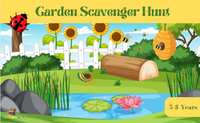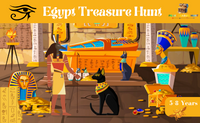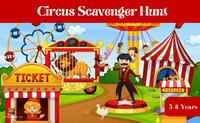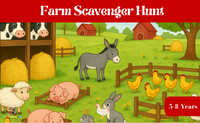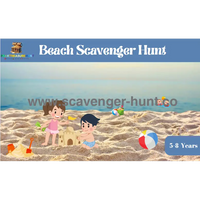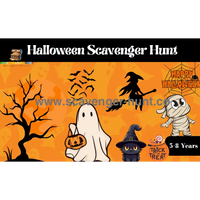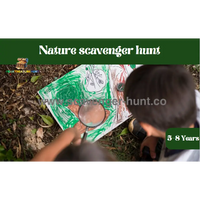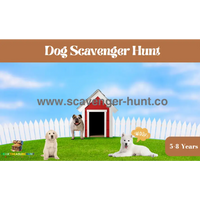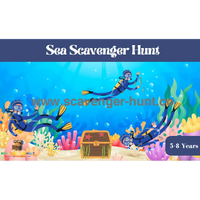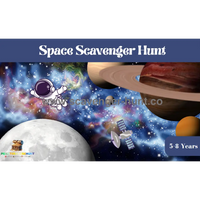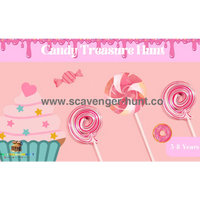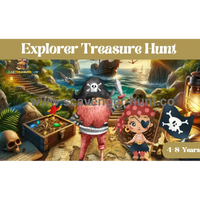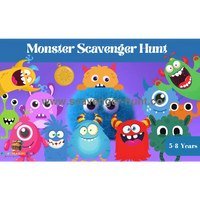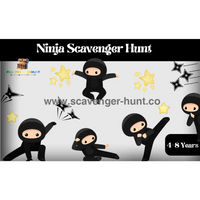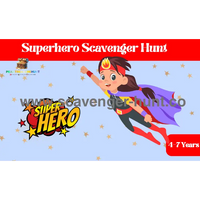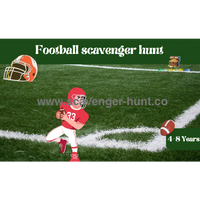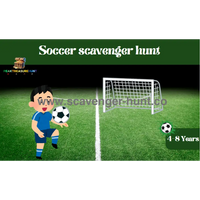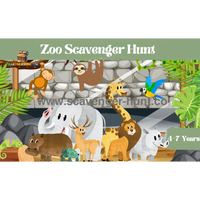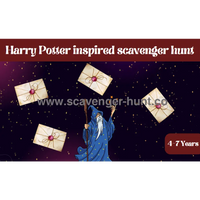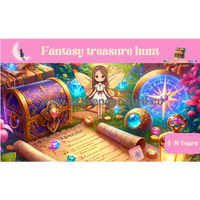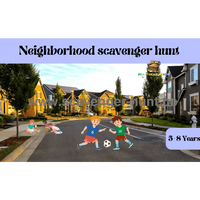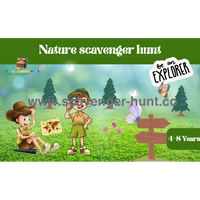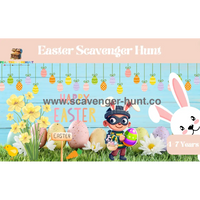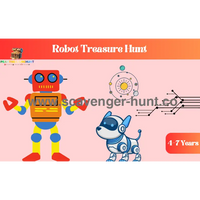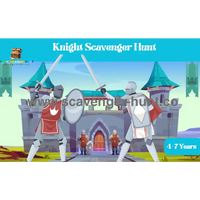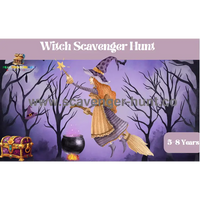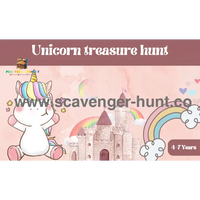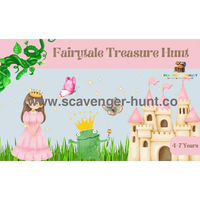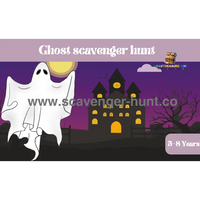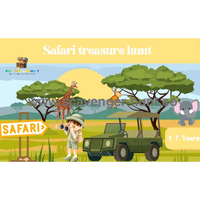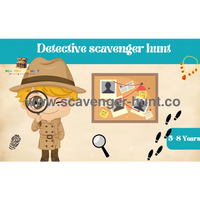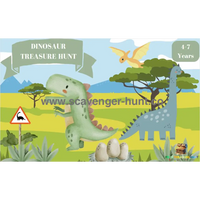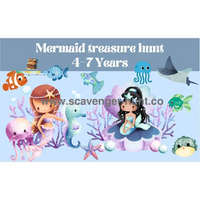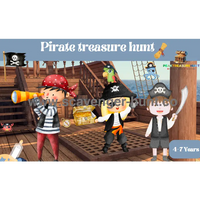In today's digital age, it's more important than ever to encourage children to engage with the natural world around them. As parents, we strive to provide opportunities for our kids to learn and grow while having fun. One fantastic way to achieve this is through a Printable Nature Scavenger Hunt PDF. This article aims to introduce you to this exciting activity and guide you through its benefits and implementation.
The Importance of Outdoor Exploration
Encouraging children to spend time outdoors is crucial for their physical and mental development. Research shows that exposure to nature has numerous benefits, including improved cognitive function, increased creativity, and reduced stress levels. By providing children with opportunities to explore the outdoors, we foster a deeper connection with the environment and instill a sense of stewardship for the natural world.
Physical Health Benefits
Outdoor exploration is a fantastic way for children to stay physically active. Unlike indoor activities, outdoor play often involves running, climbing, and other forms of exercise that are essential for building strong muscles and bones. Regular physical activity can help combat the rising rates of childhood obesity and associated health issues such as diabetes and heart disease. Moreover, exposure to sunlight helps children produce vitamin D, which is vital for bone health and immune function.
Cognitive Development
Spending time in nature has been shown to enhance cognitive development in children. Engaging with natural environments stimulates curiosity and encourages problem-solving and critical thinking skills. For instance, navigating a trail, identifying different plants, or understanding animal behavior requires children to use their brains in innovative ways. Studies have found that children who spend more time outdoors have better attention spans and perform better academically compared to those who spend more time indoors.
Emotional and Mental Well-Being
The mental health benefits of outdoor exploration cannot be overstated. Nature provides a calming effect, which can reduce stress, anxiety, and symptoms of depression. The serene environment of a forest or park helps children feel more relaxed and happy. Additionally, the unpredictability of natural settings can teach children resilience and adaptability, helping them cope better with challenges and setbacks in their everyday lives.
Social Skills and Cooperation
Outdoor activities often require teamwork and cooperation, which are crucial for developing social skills. When children engage in group activities such as scavenger hunts, they learn to communicate, share, and work together towards a common goal. These interactions can improve their ability to collaborate, resolve conflicts, and build strong relationships. Moreover, unstructured play in natural settings allows children to invent games and roles, fostering creativity and imagination.
Environmental Stewardship
By exploring nature, children develop a sense of wonder and appreciation for the environment. This connection is the foundation for environmental stewardship. When children see the beauty and complexity of the natural world firsthand, they are more likely to care about protecting it. Teaching children about conservation, recycling, and sustainable practices during their outdoor adventures can instill lifelong values of environmental responsibility.
Enhanced Creativity
Nature is an endless source of inspiration for creativity. The varied textures, colors, and shapes found in natural settings stimulate children's imaginations. Whether they're building a fort from branches, creating art from leaves and flowers, or writing stories inspired by their surroundings, outdoor exploration can significantly boost creative thinking. Unlike structured indoor environments, nature allows children to explore and create without limitations.
Connection to Community and Culture
Outdoor exploration also helps children connect with their community and cultural heritage. Many natural spaces, such as parks and nature reserves, are integral parts of local history and culture. Learning about the plants, animals, and landscapes that are unique to their region can give children a sense of place and identity. Participating in community clean-ups, tree planting, or local conservation projects can strengthen their connection to their community and foster a sense of belonging.
Practical Life Skills
Spending time outdoors teaches children practical life skills that are difficult to acquire indoors. Skills such as navigation, using a compass, building a fire, or identifying edible plants can be both educational and empowering. These experiences not only build self-confidence but also prepare children for real-life situations. Additionally, understanding weather patterns, animal behavior, and ecological systems can provide a broader perspective on how the world works.
👉👉👉👉
DISCOVER OUR NATURE SCAVENGER HUNT!!👈👈👈👈

What is a Nature Scavenger Hunt?
A Nature Scavenger Hunt is a fun and educational activity that challenges children to search for specific items or phenomena in their natural surroundings. Participants are provided with a list of items to find, such as pine cones, bird nests, or animal tracks, and are encouraged to use their senses to observe and identify them. This hands-on experience not only promotes learning about the environment but also enhances observational skills and encourages teamwork and cooperation.
The Concept of a Scavenger Hunt
At its core, a scavenger hunt is a game where participants seek to find a list of items. When adapted to the natural world, it becomes a powerful tool for engaging children with their environment. The list typically includes various natural objects and phenomena, prompting children to explore their surroundings in search of these items. This active engagement with nature fosters curiosity and a spirit of adventure.
Benefits of a Nature Scavenger Hunt
A Nature Scavenger Hunt offers multiple benefits beyond simple entertainment. It combines physical activity with educational content, making learning a dynamic and enjoyable process. Children learn to observe details, identify different species, and understand ecological relationships. Additionally, it enhances their sensory perception as they touch, smell, and listen to their environment.
Types of Items to Include
The items on a scavenger hunt list can vary widely depending on the environment and the season. Common items include:
-
Plants: Leaves, flowers, pine cones, and tree bark.
-
Animals: Birds, insects, animal tracks, and nests.
-
Natural Phenomena: Clouds, rocks, streams, and puddles.
-
Man-made Elements: Litter, signs, and pathways.
Including a mix of these items ensures a comprehensive exploration of the natural world, catering to a wide range of interests and observational skills.
Customizing the Hunt
One of the best aspects of a Printable Nature Scavenger Hunt PDF is its flexibility. You can tailor the scavenger hunt to suit different age groups and skill levels. For younger children, you might include simple items like a red leaf or a smooth stone. For older children, you can add more complex tasks, such as identifying different bird songs or finding evidence of animal activity. Customizing the hunt ensures that it remains challenging and engaging for all participants.
Promoting Teamwork and Social Skills
A scavenger hunt can be done individually, but it’s often more fun and beneficial when done in groups. Working in teams, children learn to communicate, delegate tasks, and share discoveries. This collaborative effort builds social skills and teaches children the value of cooperation and teamwork. It also provides opportunities for peer learning, where children can share knowledge and insights with each other.
Creating Your Printable Scavenger Hunt PDF
Designing a Printable Nature Scavenger Hunt PDF is an easy and enjoyable process that allows you to customize the activity according to your environment and the interests of the participants. Here’s a step-by-step guide to creating your own scavenger hunt.
Step 1: Selecting Items
Start by identifying a variety of items that are commonly found in your local environment. Consider the following categories:
-
Plants: Different types of leaves, flowers, seeds, and tree bark.
-
Animals: Birds, insects, animal tracks, and nests.
-
Natural Elements: Rocks, streams, clouds, and shadows.
-
Human Elements: Litter, signs, paths, and fences.
Ensure the items are appropriate for the season and location. For example, include colorful leaves in the fall or budding flowers in the spring.
Step 2: Categorizing Items
Organize the items into categories to make the scavenger hunt more structured. This can include categories like:
-
Flora: Different types of plants and trees.
-
Fauna: Various animals and insects.
-
Earth Elements: Rocks, soil, and water features.
-
Sky Elements: Cloud shapes and weather patterns.
Categorizing helps children focus on different aspects of nature and makes the activity more educational.
Step 3: Designing the PDF
Use a simple and visually appealing design for your Printable Nature Scavenger Hunt PDF. Include:
-
Title and Instructions: A clear title and simple instructions explaining how to play.
-
Images: Pictures or illustrations of each item to help younger children identify them.
-
Checklists: Boxes next to each item for children to tick off as they find them.
Numerous online tools and templates are available to assist with the design process, making it easy to create a professional-looking PDF.
Step 4: Adding Educational Information
Enhance the scavenger hunt by including interesting facts about each item. For example, provide a brief description of the plant or animal, its habitat, and its role in the ecosystem. This adds an educational dimension to the activity, encouraging children to learn more about the items they find.
Step 5: Testing and Refining
Before finalizing your Printable Nature Scavenger Hunt PDF, test it with a small group of children. Observe how they interact with the list and note any difficulties or confusions they encounter. Use this feedback to refine the scavenger hunt, making any necessary adjustments to improve clarity and engagement.
Implementing the Scavenger Hunt
Once you’ve created your Printable Nature Scavenger Hunt PDF, it’s time to put it into action. Implementation involves choosing a suitable location, gathering supplies, and guiding the children through the activity.
Choosing a Location
Select a location that is safe and rich in natural features. Parks, nature reserves, and even your backyard can be excellent choices. Ensure the area is suitable for the age and abilities of the participants. For instance, younger children might need a flat, easily accessible area, while older children could handle more challenging terrain.
Gathering Supplies
Prepare the necessary supplies before starting the scavenger hunt. These might include:
-
Scavenger Hunt Lists: Printed copies of your Printable Nature Scavenger Hunt PDF.
-
Pencils or Crayons: For ticking off items as they are found.
-
Clipboards: To provide a stable surface for writing.
-
Magnifying Glasses: For a closer look at small items.
-
Bags for Collecting Items: To gather found objects if the hunt includes physical collection.
Setting the Rules
Before starting the scavenger hunt, gather the children and explain the rules. Important points to cover include:
-
Safety: Stay within the designated area, don’t touch harmful plants or animals, and be aware of your surroundings.
-
Respect for Nature: Look but don’t disturb wildlife, leave plants and animals where they are, and follow “Leave No Trace” principles.
-
Teamwork: Encourage cooperation, sharing, and helping each other.
-
Completion: Explain how to mark items on their list and what to do once they’ve found everything.
Starting the Hunt
Once everyone understands the rules, distribute the Printable Nature Scavenger Hunt PDFs and other supplies. Divide the participants into teams or pairs if you’re working with a larger group. Give a clear starting signal and let the adventure begin!
Facilitating the Hunt
As the children explore, move around the area to supervise and offer guidance. Encourage them to ask questions and share their discoveries. If you notice a child struggling, provide hints or pair them with another child for support. Use this time to point out interesting aspects of nature they might not have noticed, further enriching their learning experience.
Debriefing and Sharing
After the scavenger hunt, gather the children and allow them to share their findings. This can be done in several ways:
-
Show and Tell: Have each child or team present what they found and share any interesting facts.
-
Discussion: Facilitate a group discussion about their favorite parts of the hunt, any challenges they faced, and what they learned.
-
Reflection: Encourage children to reflect on how the activity made them feel and what they discovered about nature.
This debriefing session helps consolidate their learning and fosters a sense of accomplishment.
👉👉👉👉DISCOVER OUR NATURE SCAVENGER HUNT!!👈👈👈👈

Learning Through Exploration
The beauty of a Nature Scavenger Hunt lies in its ability to combine learning with outdoor exploration. As children search for items on their list, they have the opportunity to learn about the natural world firsthand.
Whether they're identifying different types of leaves, listening for bird calls, or observing insect behavior, each discovery contributes to their understanding of ecology and biodiversity. Additionally, the thrill of discovery and the sense of accomplishment they experience boost their confidence and curiosity.
Hands-On Learning
One of the key benefits of a Nature Scavenger Hunt is the hands-on learning it provides. Unlike classroom-based education, a scavenger hunt allows children to engage directly with the natural world. This experiential learning helps them to understand complex concepts through real-life observation and interaction. For example, finding a caterpillar on a leaf can lead to discussions about life cycles, while observing different rock formations can introduce basic geology.
Observational Skills
A scavenger hunt sharpens children's observational skills. As they search for specific items, they learn to pay close attention to their surroundings, noticing details they might otherwise overlook. This heightened awareness can enhance their ability to focus and improve their attention to detail in other areas of life, such as schoolwork and hobbies.
Critical Thinking and Problem-Solving
Each item on the scavenger hunt list presents a mini-challenge that requires critical thinking and problem-solving. Children must figure out where to find certain items, how to identify them, and sometimes even how to access them safely. This process encourages analytical thinking and resourcefulness. For example, if they need to find a bird's nest, they might consider where birds are likely to build nests and look for clues such as bird calls or movement in trees.
Creativity and Imagination
Nature itself is a great stimulant for creativity and imagination. During a scavenger hunt, children might be inspired to create stories about the items they find or imagine the lives of the animals they observe. This creative thinking is not only fun but also important for cognitive development. Encouraging children to draw or write about their experiences after the scavenger hunt can further enhance this creative process.
Emotional Growth
The sense of achievement that comes from successfully completing a scavenger hunt can significantly boost a child’s self-esteem and confidence. Overcoming the challenges presented by the hunt—whether it's finding a particularly elusive item or working together with peers—can foster a sense of pride and accomplishment. Additionally, spending time in nature has been shown to reduce stress and anxiety, promoting overall emotional well-being.
Fostering a Love for Nature
A Nature Scavenger Hunt can ignite a lifelong passion for the outdoors. By directly engaging with the environment, children develop a deeper appreciation for the natural world. This connection can inspire a commitment to conservation and environmental stewardship. Encouraging children to journal about their experiences or start a nature collection can further this bond, turning a simple scavenger hunt into a lasting interest.
Social Interaction
When done in groups, a scavenger hunt can enhance social skills. Children learn to communicate effectively, share their findings, and work as a team to achieve common goals. These interactions can help build friendships and teach important life skills such as cooperation, negotiation, and leadership. Group activities also provide a platform for children to learn from each other, fostering a collaborative learning environment.
Physical Health and Activity
Lastly, a Nature Scavenger Hunt promotes physical health through active exploration. Unlike sedentary indoor activities, a scavenger hunt involves walking, running, climbing, and other physical activities that are essential for healthy growth. Regular physical activity helps build strong muscles and bones, improves cardiovascular health, and can even enhance mood and energy levels.
Printable Nature Scavenger Hunt PDF FAQ
1. What age range is the Nature Scavenger Hunt suitable for?
The Nature Scavenger Hunt is designed for children aged 4 to 12 years old. However, it can be adapted to suit younger or older participants by adjusting the difficulty level of the items on the list.
2. Can the scavenger hunt be done indoors?
While the scavenger hunt is primarily intended for outdoor exploration, certain items on the list, such as household plants or pictures of animals, can be found indoors. However, to fully experience the wonders of nature, we recommend conducting the scavenger hunt outdoors whenever possible.
3. How can parents enhance the learning experience during the scavenger hunt?
Parents can enhance the learning experience by encouraging children to ask questions, discuss their observations, and research unfamiliar items they encounter. Additionally, incorporating discussions about conservation and environmental stewardship can deepen their appreciation for the natural world.
4. Are there any safety precautions parents should take during the scavenger hunt?
It's essential to prioritize safety during the scavenger hunt. Parents should choose a safe outdoor location, supervise children at all times, and ensure they are dressed appropriately for the weather and terrain. Additionally, be mindful of potential hazards such as uneven terrain, poisonous plants, or wildlife encounters.
5. How can parents extend the learning beyond the scavenger hunt?
Parents can extend the learning beyond the scavenger hunt by engaging children in follow-up activities such as nature journaling, creating art inspired by their outdoor discoveries, or researching specific topics related to their findings. By nurturing their curiosity and creativity, we can foster a lifelong love of nature in our children.
Conclusion
In conclusion, a Printable Nature Scavenger Hunt PDF is an excellent tool for engaging children with the natural world and promoting outdoor exploration and learning. By providing opportunities for hands-on experiences in nature, we can inspire curiosity, creativity, and a deep appreciation for the environment in the next generation of environmental stewards. So why wait? Download your scavenger hunt today and embark on an unforgettable adventure with your young explorers!
Discover our Complete Scavenger Hunts Collection.




